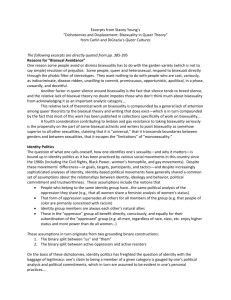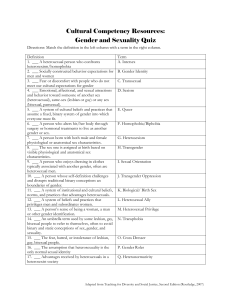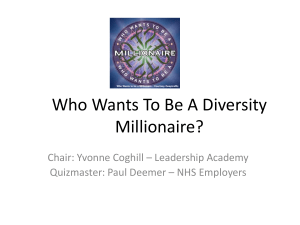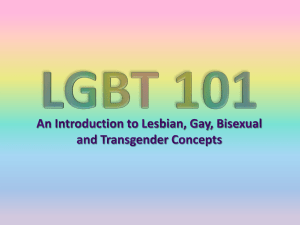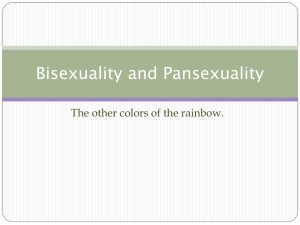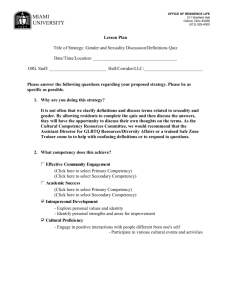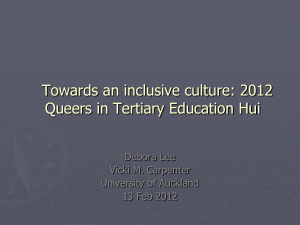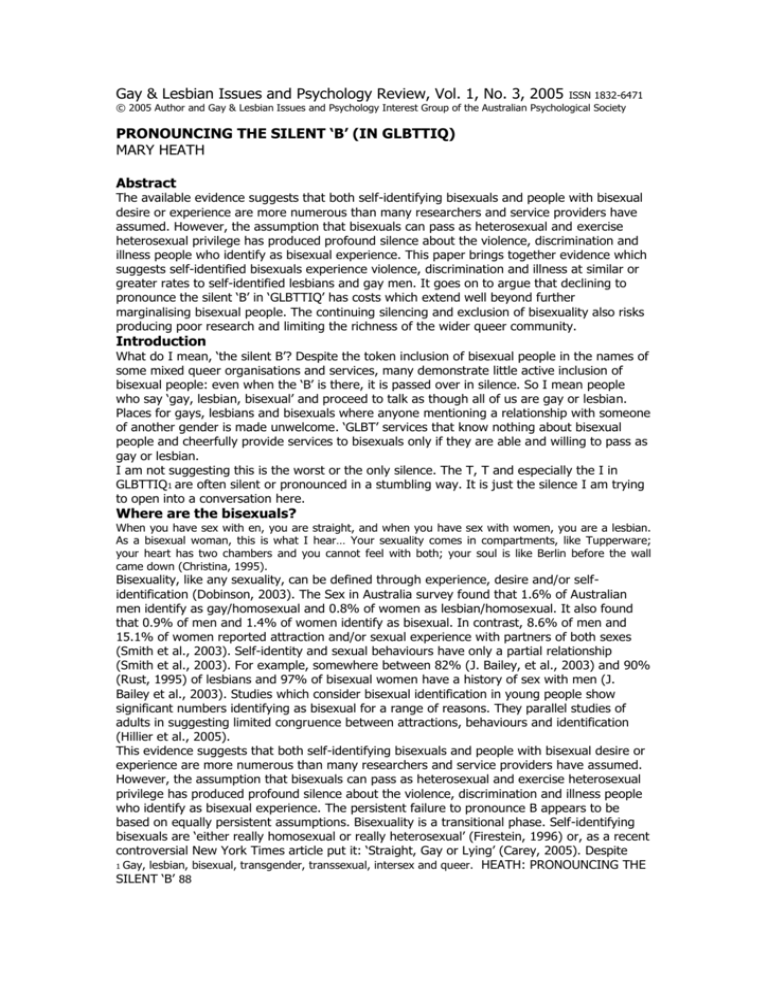
Gay & Lesbian Issues and Psychology Review, Vol. 1, No. 3, 2005
ISSN 1832-6471
© 2005 Author and Gay & Lesbian Issues and Psychology Interest Group of the Australian Psychological Society
PRONOUNCING THE SILENT ‘B’ (IN GLBTTIQ)
MARY HEATH
Abstract
The available evidence suggests that both self-identifying bisexuals and people with bisexual
desire or experience are more numerous than many researchers and service providers have
assumed. However, the assumption that bisexuals can pass as heterosexual and exercise
heterosexual privilege has produced profound silence about the violence, discrimination and
illness people who identify as bisexual experience. This paper brings together evidence which
suggests self-identified bisexuals experience violence, discrimination and illness at similar or
greater rates to self-identified lesbians and gay men. It goes on to argue that declining to
pronounce the silent ‘B’ in ‘GLBTTIQ’ has costs which extend well beyond further
marginalising bisexual people. The continuing silencing and exclusion of bisexuality also risks
producing poor research and limiting the richness of the wider queer community.
Introduction
What do I mean, ‘the silent B’? Despite the token inclusion of bisexual people in the names of
some mixed queer organisations and services, many demonstrate little active inclusion of
bisexual people: even when the ‘B’ is there, it is passed over in silence. So I mean people
who say ‘gay, lesbian, bisexual’ and proceed to talk as though all of us are gay or lesbian.
Places for gays, lesbians and bisexuals where anyone mentioning a relationship with someone
of another gender is made unwelcome. ‘GLBT’ services that know nothing about bisexual
people and cheerfully provide services to bisexuals only if they are able and willing to pass as
gay or lesbian.
I am not suggesting this is the worst or the only silence. The T, T and especially the I in
GLBTTIQ1 are often silent or pronounced in a stumbling way. It is just the silence I am trying
to open into a conversation here.
Where are the bisexuals?
When you have sex with en, you are straight, and when you have sex with women, you are a lesbian.
As a bisexual woman, this is what I hear… Your sexuality comes in compartments, like Tupperware;
your heart has two chambers and you cannot feel with both; your soul is like Berlin before the wall
came down (Christina, 1995).
Bisexuality, like any sexuality, can be defined through experience, desire and/or selfidentification (Dobinson, 2003). The Sex in Australia survey found that 1.6% of Australian
men identify as gay/homosexual and 0.8% of women as lesbian/homosexual. It also found
that 0.9% of men and 1.4% of women identify as bisexual. In contrast, 8.6% of men and
15.1% of women reported attraction and/or sexual experience with partners of both sexes
(Smith et al., 2003). Self-identity and sexual behaviours have only a partial relationship
(Smith et al., 2003). For example, somewhere between 82% (J. Bailey, et al., 2003) and 90%
(Rust, 1995) of lesbians and 97% of bisexual women have a history of sex with men (J.
Bailey et al., 2003). Studies which consider bisexual identification in young people show
significant numbers identifying as bisexual for a range of reasons. They parallel studies of
adults in suggesting limited congruence between attractions, behaviours and identification
(Hillier et al., 2005).
This evidence suggests that both self-identifying bisexuals and people with bisexual desire or
experience are more numerous than many researchers and service providers have assumed.
However, the assumption that bisexuals can pass as heterosexual and exercise heterosexual
privilege has produced profound silence about the violence, discrimination and illness people
who identify as bisexual experience. The persistent failure to pronounce B appears to be
based on equally persistent assumptions. Bisexuality is a transitional phase. Self-identifying
bisexuals are ‘either really homosexual or really heterosexual’ (Firestein, 1996) or, as a recent
controversial New York Times article put it: ‘Straight, Gay or Lying’ (Carey, 2005). Despite
1 Gay, lesbian, bisexual, transgender, transsexual, intersex and queer. HEATH: PRONOUNCING THE
SILENT ‘B’ 88
the actual or potential availability of heterosexual privilege, evidence suggests self-identifying
bisexuals have considerable experiences of violence, discrimination and ill-health. This paper
considers the evidence for this claim, focusing on the available information about the
experiences of people who identify themselves as bisexual.
Violence
Australian research shows high numbers of lesbians and gay men experience abuse, threats
and violence on the grounds of their sexuality (Schwartzkoff et al., 2003). However, we have
little dependable information about violence against people who identify as bisexual. Data is
collected only incidentally in surveys advertised and circulated in gay and/or lesbian venues
which may not welcome bisexuals.
For example, recent research for the Attorney General’s Department of NSW is exactly what it
says it is: ‘a report on homophobic hostilities and violence against gay men and lesbians in
New South Wales’ (Schwartzkoff et al., 2003). Only gay men and lesbians were sampled.
Responses from bisexuals who participated despite its title and the absence of publicity to
bisexual organisations were included. Six percent of respondents self-identified as bisexual
(Schwartzkoff et al., 2003). Similarly, a major Victorian report collected seven percent
bisexual respondents (Victorian Gay and Lesbian Rights Lobby, 2000). These figures
significantly under represent the proportion of bisexuals in the population and consequently
mislead readers.
Bisexual respondents to the NSW study reported lifetime rates of experiences of abuse,
harassment or violence similar to those reported by gay men and higher than those reported
by lesbians. Bisexual respondents reported impacts of ‘anti gay/anti lesbian abuse or violence’
on their behaviour, emotional states, health and friendships above the reported responses of
both the lesbian and gay male respondents on 10 of 13 measures (Schwartzkoff et al., 2003,
p. 51).
Sex in Australia found that gay men were more than four times as likely to report being
forced or frightened into sexual activity as heterosexual men. Bisexual men reported sexual
coercion at even higher rates. Lesbians were much more likely to report being forced or
frightened into sex than heterosexual women (35.3% compared with 20.9%). Almost one in
every two bisexual women reported experiencing sexual coercion (de Visser, et al., 2003).
Discrimination
The state of knowledge in this area is ‘fragmentary’ (Herek, 2002). One US study, using a
national probability sample, tested heterosexual people’s attitudes to a range of ethnic and
religious groups, ‘homosexual’ people and ‘people who have AIDS’. ‘Respondents’ attitudes
toward bisexual men and women were more negative than all other groups except injecting
drug users’ (Herek, 2002) .
Another study found that bisexuals were less acceptable to heterosexuals than either lesbians
or gay men. 38% found lesbians unacceptable and 43% found gay men unacceptable, 50%
found bisexual women unacceptable and 61% found bisexual men unacceptable. These
findings were particularly pronounced in heterosexual men, who “rated bisexual men as very
unacceptable, but were more tolerant… of bisexuality in women” (Eliason, 1997, p. 324).
Several male respondents wrote unsolicited comments about possible threesomes with a
female bisexual partner (Eliason, 1997). Undoubtedly this is a form of ‘acceptability’, but one
many bisexual women do not find flattering.
Experiences of discrimination may explain bisexuals’ apparent unwillingness to disclose their
sexuality. A recent English study found lesbians and gay men were more likely ‘to be open
about their sexuality’ to family, friends, workmates and health professionals than bisexuals
(King et al., 2003). Disclosure is more likely to result in well-being, as well as being necessary
to allow access to the resilience benefits of group affiliation (Meyer, 2003). However, bisexual
people lack a visible community to identify with (Schilder et al., 2001). There is no ‘bisexual
community’ to parallel the gay and lesbian communities, which draw their substance from
multiple organisations, services and friendship networks. In comparison there are very few
HEATH: PRONOUNCING THE SILENT ‘B’ 89
bisexual organisations Australia-wide and no bi-specific services.
Health and illness
Australian research suggests bisexual people experience poorer mental health than the
general population. A community survey showed bisexual self-identification was “associated
with worse mental health than heterosexual orientation on a range of measures of
psychological distress, with the homosexual group falling between the other two” (Jorm et
al., 2002, p. 425). Bisexual participants reported more childhood adversity, current adverse
life events, financial difficulties and less support than the heterosexuals.
In spite of these findings, as gay and lesbian issues have begun to reach Australian health
policy machinery, bisexual people have been almost completely excluded. The Victorian
Ministerial Advisory Committee on Gay and Lesbian Health (MACGLH), for example, notes the
lack of research on the sexual health needs of ‘bisexually active’ people, but its reports
propose nothing to rectify this absence (MACGLH, 2002, p. 26). The primary recommendation
of its Action Plan is a well-being policy and research unit which would “focus on gay and
lesbian health but address bisexual, trans and intersex health issues in so far as they overlap
with those of gay men and lesbians” (MACGLH, 2003, p. 149).
However, bisexual people may face distinct issues. One example is the lack of recognition and
acceptance of bisexuality not only within mainstream society, but also within gay and lesbian
communities. If participation in community is a key index of physical and mental health
(Bailey, Gurevich, & Mathieson, 2000) and a crucial buffer against the stressful effects of
homophobia (Meyer, 2003), bisexual people are at particular risk.
The lack of welcome bisexual people often experience within gay and lesbian communities as
well as the general community is inadequately understood by health providers, who are
consequently unable ‘to assess distress, anxiety, relationships or risk appropriately’
(Dobinson, 2003). This should be cause for specific concern, rather than the comprehensive
silence found within existing research and service delivery.
Can’t we all be SSAY, WSW and MSM together?
Research often proceeds as if collapsing data about bisexual and homosexual respondents
and analysing data “as if all the participants are homosexual” is appropriate (Firestein, 1996,
p. 271). Any participant who has had a same-sex encounter is classified as gay or lesbian.
After this vanishing trick, the research conveys the impression that there are no bisexual
people or bisexual-specific issues. If bisexuality is mentioned, “the theoretical implication[s]
simply go unremarked” (Eadie, 1993, p. 148).
Studies of ‘men who have sex with men’ (MSM), in particular, discuss bisexual men as “risk
factors without … appreciation of the context of their basic health concerns, experiences or
beliefs” (Schilder et al., 1999: 120). Similarly, as a subcategory of ‘women who have sex with
women’ (WSW), bisexual women appear as vectors of disease or threatening, defective
lesbians.
Failing to differentiate bisexual respondents may mean that research produces inaccurate
information (Jorm et al., 2002). Although the language of SSAY, MSM and WSW represents
an attempt to be more inclusive, it has limitations. In particular, this terminology makes it
“possible to ignore affectional relations, cultural values and beliefs … within these groups”
(Schilder et al., 2001, p. 1644). It also makes it possible to ignore pressure for denial of
bisexual identity and activity from peers and isolation from family, peers and gay/lesbian
communities. Further, it erases the different responses bisexuals report to disclosing their
sexuality in contexts including health care settings (King et al., 2003). Unless behaviourdescriptive language is accompanied by awareness that people of common behaviours do not
always share identities, communities, cultures or resources, it will only go part of the way
toward inclusion. HEATH: PRONOUNCING THE SILENT ‘B’ 90
Tokenism
GLBTTIQ events often pay no specific attention to bisexuality and community groups which
claim to be inclusive of lesbians, gays and bisexuals may fail to provide safe, accepting
environments for bisexual people (Firestein, 1996). A similar difficulty with pronouncing the B
word appears in research. An innovative Canadian study into lesbian and bisexual women’s
health needs interviewed a limited number of bi-identifying participants. Although purposive
sampling was used to attempt to create an ethnically and socioeconomically diverse sample,
no efforts to ensure appropriate representation of bisexual women were reported (Mathieson,
Bailey, & Gurevich, 2002, p. 187).
One paper reporting the resulting research begins with references to ‘the lesbian/bisexual
community’. Part-way through the paper, they are replaced with references to ‘heterosexual
and lesbian communities’. The only bisexual woman quoted as such stated that she was
ostracised by the ‘lesbian community’ (Bailey et al., 2000, p. 13).
The authors recognise that community involves regulatory norms, with resulting impacts on
health. They suggest there are “multiple intersections and fractures between individual and
collective ideas of what it means to be a lesbian or bisexual woman”. Bisexual women
represent an example of tension, which “might represent a political threat to a lesbian
community” (Mathieson et al., 2002, p. 11). Bisexual women are portrayed as boundary
markers of lesbian community, rather than open inhabitants of such communities.
Having made only one bisexual-specific reference to their data, the paper concludes: “The
inclusion of bisexual women … is important because their presence adds an extra dimension
to an understanding of how women with multiple identities work toward … well-being”
(Mathieson et al., 2002, p. 194-195). Bisexuality is granted “a rhetorical weight which is
unfortunately belied by the failure to give it any theoretical attention” (Eadie, 1993, p. 121). I
have not used this example because it is particularly appalling: rather, it is capable of analysis
because it attempts bisexual inclusion.
The level of sample bias in studies which claim to include lesbians and bisexual women or gay
men and bisexual men would be clearly recognisable as affecting the representativeness of
the sample in relation to other populations. However, studies which consider ethnic, socioeconomic and educational sample bias completely fail to consider whether declining to
differentiate between homosexual and bisexual participants might produce bad science (Jorm
et al., 2002).
Who pays?
Most of the time, I think about the costs to bisexual people of exclusion from gay and lesbian
initiatives. Freedom from violence, discrimination and ill-health are for everyone. They are not
optional extras only for some. However, few people seem to be asking about the cost to
lesbian and gay communities and research of excluding bisexuals (Eadie, 1993).
Every time lesbians and gays choose bisexuals as the symbol of everything to-be-avoided,
everything a true gay or lesbian is not, gay and lesbian communities pay. People who are
newly exploring same sex attraction experience pressure to ‘get off the fence’ as the very
reverse of the welcome they were hoping to find. There are a lot of lesbians in particular,
who used to think and even to say they were bisexual (Rust, 1995). Some of them live
silently and in distress with other-sex attraction or consensual other-sex-experiences.
Requiring people to hide or be silent does not create something that deserves the name
‘community’.
It is sometimes said that bisexuals make queer spaces (and lesbian spaces, in particular),
unsafe. Yet bisexual exclusion makes queer communities unsafe for a lot of people who think
of themselves as lesbian or gay, or who may do so in future. Is this a price we want to pay?
“To choose to live in a safe space (which may not be safe for everyone in it) is to settle for
less than we deserve, by neglecting the possibility of working in coalitions whereby the world
might be safe for everyone” (Eadie, 1993, p. 163).
Author note
Mary Heath lectures in law at Flinders University. She and Ea Mulligan are currently HEATH:
PRONOUNCING THE SILENT ‘B’ 91
engaged in research into lesbian and bisexual women’s strategies for achieving well-being
funded by the Australian Lesbian Medical Association and Flinders University. Thanks to
Truffy Maginnis, Ea Mulligan and Sal Humphreys for their support in this project. School of
Law, Flinders University. Mary.heath@flinders.edu.au
References
Bailey, J., et al. (2003). Sexual behaviour of lesbians and bisexual women. Sexually
Transmitted Infections, 79, 147.
Bailey, N., Gurevich, M., & Mathieson, C. (2000). Invoking community: Rethinking the health of
lesbian and bisexual women. Ottawa: Canadian Research Institute for the Advancement of
Women.
Christina, G. (1995). Bisexuality. In N. Tucker, L. Highleyman & R. Kaplan (Eds.), Bisexual
politics: Theories, queries, and visions (pp. 161). New York: Harrington Park Press.
Carey, B. (2005). Straight, gay or lying? Bisexuality revisited, New York Times, July 5.
de Visser, R., et al. (2003). Experiences of sexual coercion among a representative sample of
adults. Australian and New Zealand Journal of Public Health, 27, 198.
Dobinson, C. (2003). Improving the access and quality of public health services for bisexuals.
Toronto: Ontario Public Health Association.
Eadie, J. (1993). Activating bisexuality. In J. Bristow & A. Wilson (Eds.), Activating theory:
Lesbian, gay, bisexual politics (pp. 121). London: Lawrence and Wishart.
Eliason, M. (1997). The prevalence and nature of biphobia in heterosexual undergraduate
students. Archives of Sexual Behaviour, 26, 317.
Firestein, B. (1996). Bisexuality as paradigm shift. In B. Firestein (Ed.), Bisexuality: The
psychology and politics of an invisible minority. London: Sage.
Herek, G. (2002). Heterosexuals’ attitudes toward bisexual men and women in the United
States. Journal of Sex Research, 39, 264.
Hillier, L., Turner., A. & Mitchell, A. (2005). Writing themselves in again. Melbourne:
Australian Research Centre in Sex, Health and Society.
Jorm, A., et al. (2002). Sexual orientation and mental health: Results from a community
survey. British Journal of Psychiatry, 180, 423.
King, M., et al. (2003). Mental health and social well-being of gay men, lesbians and bisexuals
in England and Wales. London: MIND, National Association for Mental Health.
Mathieson, C., Bailey, N., & Gurevich, M. (2002). Health care services for lesbian and bisexual
women. Health Care for Women International, 23, 185.
Meyer, I. (2003). Prejudice, social stress, and mental health in lesbian, gay, and bisexual
populations. Psychological Bulletin, 129, 674.
Ministerial Advisory Committee on Gay and Lesbian Health. (2002). What’s the difference?
Melbourne: Department of Human Services.
Ministerial Advisory Committee on Gay and Lesbian Health. (2003). Health and sexual fiversity: A
health and well-being action plan for gay, lesbian, bisexual, transgender and intersex Victorians.
Melbourne: Department of Human Services.
Rust, P. (1995). Bisexuality and the challenge to lesbian politics. New York: NY University
Press.
Schilder, A., et al. (2001). 'Being dealt with as a whole person'. Care seeking and adherence:
Benefits of culturally competent care. Social Science and Medicine, 52, 1643.
Schilder, A., et al. (1999). 'A lot of things I hide': Understanding disclosure in the care of HIVpositive bisexual men. Journal of the Gay and Lesbian Medical Association, 3, 119.
Schwartzkoff, J., et al. (2003). ‘You shouldn’t have to hide to be safe’: Homophobic hostilities and
violence against gay men and lesbians in New South Wales. Sydney: Attorney General’s
Department of NSW.
Smith, A., et al. (2003). Sexual identity, sexual attraction and sexual experience among a
representative sample of adults. Australian and New Zealand Journal of Public Health, 27, 138.
Victorian Gay and Lesbian Rights Lobby. (2000). Enough Is enough. Melbourne: VGLRL.


